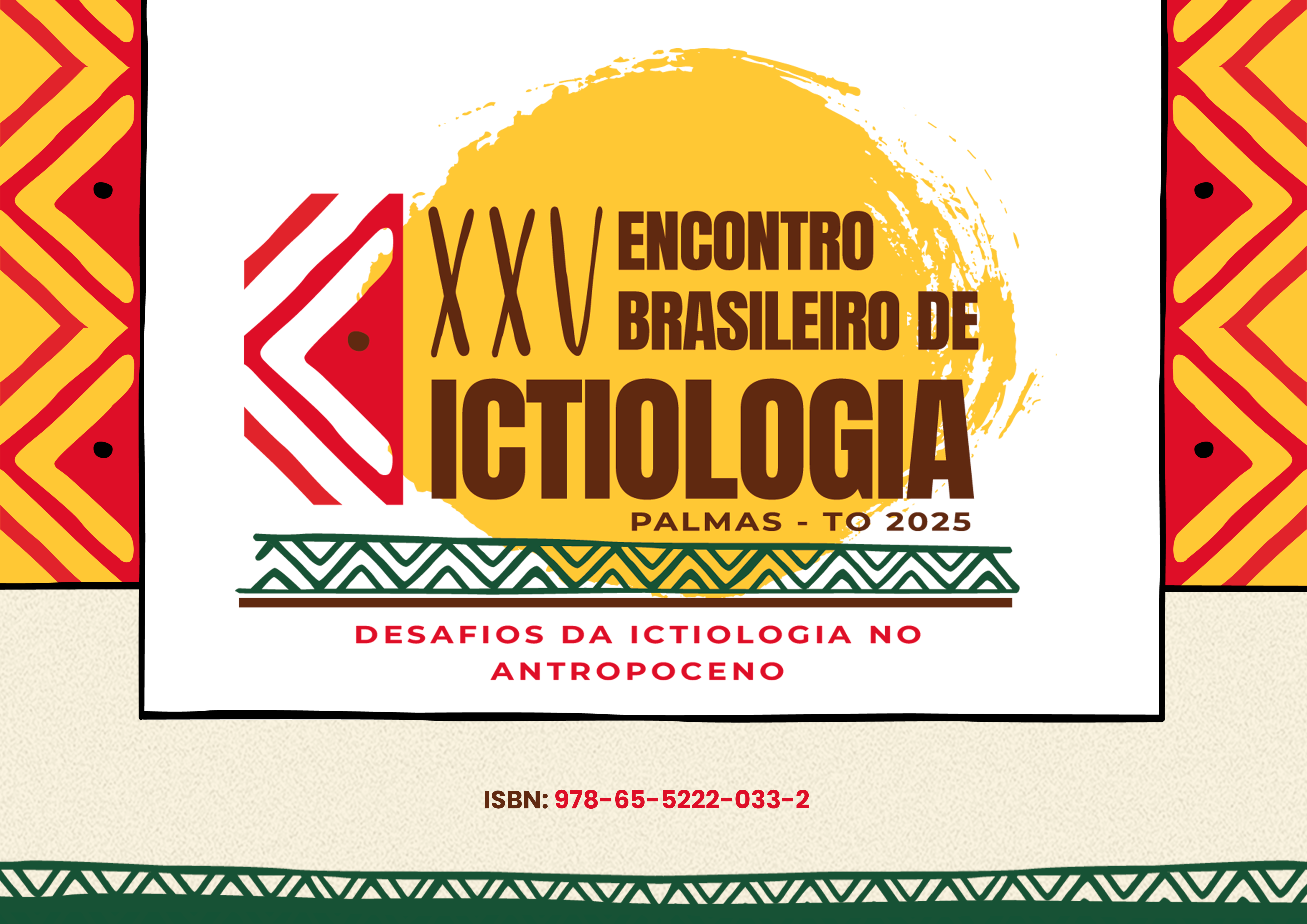BIOGEOGRAPHY AND EVOLUTION OF AUCHENIPTERIDAE (SILURIFORMES): A MOLECULAR AND MORPHOLOGICAL PERSPECTIVE
"2025-02-12 10:36:07" // app/Providers/../Base/Publico/Artigo/resources/show_includes/info_artigo.blade.php
App\Base\Administrativo\Model\Artigo {#1845 // app/Providers/../Base/Publico/Artigo/resources/show_includes/info_artigo.blade.php #connection: "mysql" +table: "artigo" #primaryKey: "id" #keyType: "int" +incrementing: true #with: [] #withCount: [] +preventsLazyLoading: false #perPage: 15 +exists: true +wasRecentlyCreated: false #escapeWhenCastingToString: false #attributes: array:35 [ "id" => 119650 "edicao_id" => 384 "trabalho_id" => 127 "inscrito_id" => 478 "titulo" => "BIOGEOGRAPHY AND EVOLUTION OF AUCHENIPTERIDAE (SILURIFORMES): A MOLECULAR AND MORPHOLOGICAL PERSPECTIVE" "resumo" => "Auchenipteridae is a monophyletic catfish family distributed along all major basins in South and Central America. In spite of the high diversification in Auchenipteridae, biogeographical analyses are almost null due to the lack of fossil records that could be compared to the contemporaneous fish diversity in this group. To start understanding this diversification, we tested how this rich landscape dynamics have shaped historically the drainage basins networks influencing the radiation of auchenipterids. Our results recovered age estimates to Auchenipteridae from the Eocene at 49.3 Ma (45–53 Ma). At this time, the basal division within Auchenipteridae occurs giving rise to the two major modern groups, Auchenipterinae and Centromochlinae aging at 42.9 Ma (38–47 Ma) and 42 Ma (37–46 Ma), respectively, before the Eocene-Oligocene boundary in the Middle at Bartonian age. It appears that Auchenipteridae started diversifying at the Paleocene-Eocene boundary in both Western Amazon and Paraná-Paraguay areas. Centromochlinae had early evolved mostly on the Paraná-Paraguay + Tapajós-Xingú areas with subsequent cladogenetic events expanded the distribution to several other areas. Most dispersal events among the bioregions, mainly by Auchenipterinae members, occurred from Western Amazonia to the Paraná-Paraguay, facilitated by intermittent connections across the low-elevation watershed (Izozog wetlands) between the upper Madeira and upper Paraguay basins. Auchenipteridae is an interesting exclusively Neotropical group to study evolutionary radiation, with remarkable contemporary richness and complex biogeographical history of high biotic interchange that appears to be associated with repetitive bursts of speciation under different mechanisms that drive to the diversification of the family." "modalidade" => "Pôster (PO)" "area_tematica" => "AT 02 - Taxonomia e Sistemática" "palavra_chave" => ", , , , " "idioma" => "Português" "arquivo" => "TRABALHO__EV205_MD4_ID478_TB127_23092024150008.pdf" "created_at" => "2025-02-13 11:08:16" "updated_at" => null "ativo" => 1 "autor_nome" => "BARBARA BORGES CALEGARI" "autor_nome_curto" => "BárbaraCalegar" "autor_email" => "barbara.calegari@gmail.com" "autor_ies" => "OUTRA / MINHA INSTITUIÇÃO NÃO ESTÁ NA LISTA" "autor_imagem" => "" "edicao_url" => "anais-do-ebi---encontro-brasileiro-de-ictiologia" "edicao_nome" => "Anais do EBI - Encontro Brasileiro de Ictiologia" "edicao_evento" => "XXV ENCONTRO BRASILEIRO DE ICTIOLOGIA" "edicao_ano" => 2025 "edicao_pasta" => "anais/ebi/2025" "edicao_logo" => null "edicao_capa" => "67b49e4d8c758_18022025115053.png" "data_publicacao" => null "edicao_publicada_em" => "2025-02-12 10:36:07" "publicacao_id" => 116 "publicacao_nome" => "Revista EBI" "publicacao_codigo" => "978-65-5222-033-2" "tipo_codigo_id" => 2 "tipo_codigo_nome" => "ISBN" "tipo_publicacao_id" => 1 "tipo_publicacao_nome" => "ANAIS de Evento" ] #original: array:35 [ "id" => 119650 "edicao_id" => 384 "trabalho_id" => 127 "inscrito_id" => 478 "titulo" => "BIOGEOGRAPHY AND EVOLUTION OF AUCHENIPTERIDAE (SILURIFORMES): A MOLECULAR AND MORPHOLOGICAL PERSPECTIVE" "resumo" => "Auchenipteridae is a monophyletic catfish family distributed along all major basins in South and Central America. In spite of the high diversification in Auchenipteridae, biogeographical analyses are almost null due to the lack of fossil records that could be compared to the contemporaneous fish diversity in this group. To start understanding this diversification, we tested how this rich landscape dynamics have shaped historically the drainage basins networks influencing the radiation of auchenipterids. Our results recovered age estimates to Auchenipteridae from the Eocene at 49.3 Ma (45–53 Ma). At this time, the basal division within Auchenipteridae occurs giving rise to the two major modern groups, Auchenipterinae and Centromochlinae aging at 42.9 Ma (38–47 Ma) and 42 Ma (37–46 Ma), respectively, before the Eocene-Oligocene boundary in the Middle at Bartonian age. It appears that Auchenipteridae started diversifying at the Paleocene-Eocene boundary in both Western Amazon and Paraná-Paraguay areas. Centromochlinae had early evolved mostly on the Paraná-Paraguay + Tapajós-Xingú areas with subsequent cladogenetic events expanded the distribution to several other areas. Most dispersal events among the bioregions, mainly by Auchenipterinae members, occurred from Western Amazonia to the Paraná-Paraguay, facilitated by intermittent connections across the low-elevation watershed (Izozog wetlands) between the upper Madeira and upper Paraguay basins. Auchenipteridae is an interesting exclusively Neotropical group to study evolutionary radiation, with remarkable contemporary richness and complex biogeographical history of high biotic interchange that appears to be associated with repetitive bursts of speciation under different mechanisms that drive to the diversification of the family." "modalidade" => "Pôster (PO)" "area_tematica" => "AT 02 - Taxonomia e Sistemática" "palavra_chave" => ", , , , " "idioma" => "Português" "arquivo" => "TRABALHO__EV205_MD4_ID478_TB127_23092024150008.pdf" "created_at" => "2025-02-13 11:08:16" "updated_at" => null "ativo" => 1 "autor_nome" => "BARBARA BORGES CALEGARI" "autor_nome_curto" => "BárbaraCalegar" "autor_email" => "barbara.calegari@gmail.com" "autor_ies" => "OUTRA / MINHA INSTITUIÇÃO NÃO ESTÁ NA LISTA" "autor_imagem" => "" "edicao_url" => "anais-do-ebi---encontro-brasileiro-de-ictiologia" "edicao_nome" => "Anais do EBI - Encontro Brasileiro de Ictiologia" "edicao_evento" => "XXV ENCONTRO BRASILEIRO DE ICTIOLOGIA" "edicao_ano" => 2025 "edicao_pasta" => "anais/ebi/2025" "edicao_logo" => null "edicao_capa" => "67b49e4d8c758_18022025115053.png" "data_publicacao" => null "edicao_publicada_em" => "2025-02-12 10:36:07" "publicacao_id" => 116 "publicacao_nome" => "Revista EBI" "publicacao_codigo" => "978-65-5222-033-2" "tipo_codigo_id" => 2 "tipo_codigo_nome" => "ISBN" "tipo_publicacao_id" => 1 "tipo_publicacao_nome" => "ANAIS de Evento" ] #changes: [] #casts: array:14 [ "id" => "integer" "edicao_id" => "integer" "trabalho_id" => "integer" "inscrito_id" => "integer" "titulo" => "string" "resumo" => "string" "modalidade" => "string" "area_tematica" => "string" "palavra_chave" => "string" "idioma" => "string" "arquivo" => "string" "created_at" => "datetime" "updated_at" => "datetime" "ativo" => "boolean" ] #classCastCache: [] #attributeCastCache: [] #dates: [] #dateFormat: null #appends: [] #dispatchesEvents: [] #observables: [] #relations: [] #touches: [] +timestamps: false #hidden: [] #visible: [] +fillable: array:13 [ 0 => "edicao_id" 1 => "trabalho_id" 2 => "inscrito_id" 3 => "titulo" 4 => "resumo" 5 => "modalidade" 6 => "area_tematica" 7 => "palavra_chave" 8 => "idioma" 9 => "arquivo" 10 => "created_at" 11 => "updated_at" 12 => "ativo" ] #guarded: array:1 [ 0 => "*" ] }



